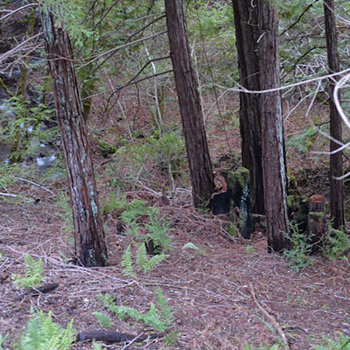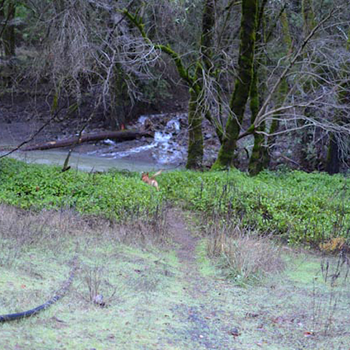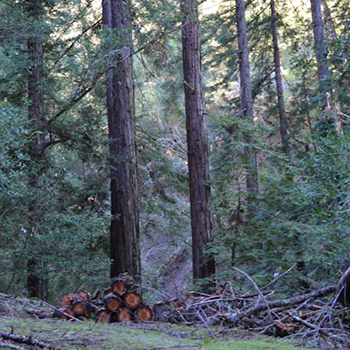Summer Issue (July 2013)
I am Denise Levine, the newest member of the Communications Committee. Our family owns almost 200 acres of the Napa River Watershed in the Mayacamas Mountains, the ridge that runs between the Napa Valley and the Sonoma Valley. Heavily forested and one of the original homesteads in the western hills, my father bought the property in the late 1970s with the intent to do a select harvest.
Our Forest contains Dougas Fir (41%), Coastal Redwood (25%), Bay Laurel (20%), Madrone (8%), Black and White Oak (3%), Tanoak (2%) and Miscellaneous Hardwoods (1%). The understory consists of hardwoods, shrubs, grasses and forbs. Species include buckeye, big leaf maple, alder, ash, willow, pacific yew, coyote brush, manzanita, chamise, gooseberry, toyon, hazelnut, buckbrush, coffeeberry, elderberry, dogwood, bear grass and poison oak.
In 1983, my husband Steven Levine and I moved into the original house, built in 1929. A year later, my father began the last timber harvest for almost twenty years in Napa not resulting in a clear cut conversion to vineyard. Long, expensive and ending in a lawsuit with Napa County (which Napa eventually lost), the harvest proceeded, but took its toll on everyone involved.
Napa environmentalists and county representatives believe agriculture equals viticulture. Trees are the “viewshed” and not to be touched.
This attitude culminated a few years ago in Napa when local environmentalists penned an initiative that deemed it illegal to cut any tree in Napa County greater than four (4) inches in diameter. Any sale or gain of any type, including barter, resulting from any forest or tree product was prohibited and criminalized. No tree was to be touched.
Napa County responded by passing their own ordinance called the Stream Setback Ordinance, almost as onerous, and over the objections of thousands of county residents.
This useless disregard of our property rights resulted in many of our neighbors on Dry Creek Road and friends from around the county launching the first successful referendum in Napa County and overturning regulations that hypocritically exempted actual culprits, while piling more regulations on responsible forest and creek owners.



But this was a turning point in our community. Our little property rights group, the Napa Valley Land Stewards was formed, (my husband and I both served as board members), and discovered that, provided with objective, educational information about what really constituted forest health, or creek health, or helped prevent or repair erosion, the community understood and supported decisions that were reality based and not simply emotional.
Our political campaign became an educational campaign. At the same time, the political structure was not quick to change, and even though Napa property owners won a decisive victory with the overturn of the county ordinance and defeat of the four-inch tree saving act, the very next morning the Land Stewards were in Sacramento in front of the Board of Forestry. Napa County was requesting two dozen additional Special Regulations for Napa be added to the Forest Practice Rules.
Our efforts and arguments were successful, and the Board denied Napa County’s request.
Now, many years later there is finally a realization that a “hands off” approach to our forested watershed has led to hazardous and potentially catastrophic fuel load conditions. CalFire and our local Resource Conservation District have welcomed our interest in restoring health to our forest. Our plan is to work with our FMP and EQIP grant, moving forward with a more extensive NTMP as the next step.
Current road access to the property is limited due to steep topography and a class one watercourse. Timber harvest activities in the 1980s utilized an extensive network of skid trails that are now partially or completely overgrown with conifer regeneration or brush.
We applied for a CFIP (California Forest Improvement Program) from CalFire in the Fall of 2011 and received a 75 percent reimbursement on our Forest Management Plan (FMP). The FMP cost was $4,500. We finished the FMP in the Spring of 2012 and applied for the USDA Environmental Quality Incentives Program (EQIP) through the Napa NRCS (Natural Resources and Conservation Service) in the Fall of 2012. In June 2013, we received a three-year 75 percent reimbursement grant totaling $41,000 dollars for road improvement, forest thinning and fuel load reduction. This is the first NRCS project in Napa that is forest improvement with no vineyard involvement. There is change in the air.
We encourage other property owners to contact their local NRCS and explore EQIP and CFIP funding grants for improvements to your property.

